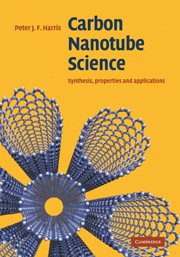Refine search
Actions for selected content:
106069 results in Materials Science
Nonequilibrium effects of primary solidification on peritectic reaction and transformation in undercooled peritectic Fe–Ni alloy
-
- Journal:
- Journal of Materials Research / Volume 25 / Issue 6 / June 2010
- Published online by Cambridge University Press:
- 31 January 2011, pp. 1025-1029
- Print publication:
- June 2010
-
- Article
- Export citation
Initial stages of oxidation of Ti45Al7Nb0.4Y alloy at 900 °C in air
-
- Journal:
- Journal of Materials Research / Volume 25 / Issue 6 / June 2010
- Published online by Cambridge University Press:
- 31 January 2011, pp. 1204-1210
- Print publication:
- June 2010
-
- Article
- Export citation
Van der Waals Interactions Between Organic Adsorbates and at Organic/Inorganic Interfaces
-
- Journal:
- MRS Bulletin / Volume 35 / Issue 6 / June 2010
- Published online by Cambridge University Press:
- 31 January 2011, pp. 435-442
- Print publication:
- June 2010
-
- Article
- Export citation
Thermal oxidation mechanism and stress evolution in Ta thin films
-
- Journal:
- Journal of Materials Research / Volume 25 / Issue 6 / June 2010
- Published online by Cambridge University Press:
- 31 January 2011, pp. 1080-1086
- Print publication:
- June 2010
-
- Article
- Export citation
A link between p-type electrical conduction and microwave dielectric loss in highly ordered Ba(Co1/3Nb2/3)O3 ceramics
-
- Journal:
- Journal of Materials Research / Volume 25 / Issue 6 / June 2010
- Published online by Cambridge University Press:
- 31 January 2011, pp. 1011-1014
- Print publication:
- June 2010
-
- Article
- Export citation
Nitrogen-doped titanium oxide microrods decorated with titanium oxide nanosheets for visible light photocatalysis
-
- Journal:
- Journal of Materials Research / Volume 25 / Issue 6 / June 2010
- Published online by Cambridge University Press:
- 31 January 2011, pp. 1096-1104
- Print publication:
- June 2010
-
- Article
- Export citation
Library
-
- Journal:
- MRS Bulletin / Volume 35 / Issue 6 / June 2010
- Published online by Cambridge University Press:
- 21 February 2012, p. 475
- Print publication:
- June 2010
-
- Article
-
- You have access
- Export citation
Strain rate dependence of anisotropic compression behavior in porous iron with unidirectional pores
-
- Journal:
- Journal of Materials Research / Volume 25 / Issue 6 / June 2010
- Published online by Cambridge University Press:
- 31 January 2011, pp. 1179-1190
- Print publication:
- June 2010
-
- Article
- Export citation
Cubic ZnxMg1−xO thin films grown by plasma-assisted molecular-beam epitaxy for optoelectronic applications
-
- Journal:
- Journal of Materials Research / Volume 25 / Issue 6 / June 2010
- Published online by Cambridge University Press:
- 31 January 2011, pp. 1072-1079
- Print publication:
- June 2010
-
- Article
- Export citation
Microstructure, thermal, and mechanical characterization of rapidly solidified high strength Fe84.3Cr4.3Mo4.6V2.2C4.6
-
- Journal:
- Journal of Materials Research / Volume 25 / Issue 6 / June 2010
- Published online by Cambridge University Press:
- 31 January 2011, pp. 1164-1171
- Print publication:
- June 2010
-
- Article
- Export citation
Origins and suppressions of parasitic emissions in ultraviolet light-emitting diode structures
-
- Journal:
- Journal of Materials Research / Volume 25 / Issue 6 / June 2010
- Published online by Cambridge University Press:
- 31 January 2011, pp. 1037-1040
- Print publication:
- June 2010
-
- Article
- Export citation

Carbon Nanotube Science
- Synthesis, Properties and Applications
-
- Published online:
- 20 May 2010
- Print publication:
- 19 March 2009
Contents
-
- Book:
- High-Temperature Levitated Materials
- Published online:
- 23 April 2010
- Print publication:
- 06 May 2010, pp vii-viii
-
- Chapter
- Export citation
3 - Heating methods
-
- Book:
- High-Temperature Levitated Materials
- Published online:
- 23 April 2010
- Print publication:
- 06 May 2010, pp 23-27
-
- Chapter
- Export citation
1 - Scientific and technological context
-
- Book:
- High-Temperature Levitated Materials
- Published online:
- 23 April 2010
- Print publication:
- 06 May 2010, pp 1-2
-
- Chapter
- Export citation
4 - Experimental techniques
-
- Book:
- High-Temperature Levitated Materials
- Published online:
- 23 April 2010
- Print publication:
- 06 May 2010, pp 28-65
-
- Chapter
- Export citation
Frontmatter
-
- Book:
- High-Temperature Levitated Materials
- Published online:
- 23 April 2010
- Print publication:
- 06 May 2010, pp i-vi
-
- Chapter
- Export citation
9 - Conclusions and prospects
-
- Book:
- High-Temperature Levitated Materials
- Published online:
- 23 April 2010
- Print publication:
- 06 May 2010, pp 204-205
-
- Chapter
- Export citation
Index
-
- Book:
- High-Temperature Levitated Materials
- Published online:
- 23 April 2010
- Print publication:
- 06 May 2010, pp 224-227
-
- Chapter
- Export citation
5 - Levitation in materials research
-
- Book:
- High-Temperature Levitated Materials
- Published online:
- 23 April 2010
- Print publication:
- 06 May 2010, pp 66-70
-
- Chapter
- Export citation
